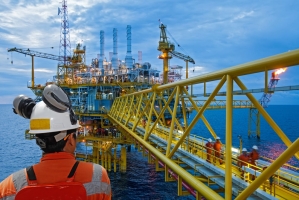***Closing date extended***
OPPORTUNITY
The decommissioning of energy assets is a relevant issue worldwide.
Two main types of assets are targeted by ESA through this funding opportunity: offshore oil & gas platforms and wind farms.
The decommissioning of oil and gas platforms involves activities such as removal of underwater structures and topside platforms; these activities have to be handled carefully in order to minimize environmental impact. Oil and gas decommissioning activities are ramping up worldwide, due to installations developed from the 1970s onward reaching their end of life.
The wind farm decommissioning market is emerging, because assets installed in the 90s and early 2000s are now approaching their end-of-life phase. The decommissioning of wind farms is less complex in terms of environmental risk impact but still entails several parts to be removed and disposed, such as turbine towers, foundations, offshore substations, meteorological masts and subsea cables, with associated complex logistic processes.
Furthermore, significant efforts are being undertaken to reuse end-of-life energy infrastructure. Examples of re-use include conversion of offshore rigs into CO2 storage tanks, reef-like infrastructures, or holidays resorts.
This environment presents new opportunities for the European industry to come up with new commercial decommissioning solutions enabled by space.
ESA intends to launch a new Invitation to Tender, to assess the technical feasibility and commercial viability of satellite-based services in support of decommissioning of energy assets. Any resulting studies are also intended to establish the roadmap for service implementation through follow-on demonstration projects.
KEY FOCUS AREAS
The following example scenarios have been identified as key focus areas:
Monitoring of environmental impact
- Residual hydrocarbons, oil spills, chemicals and harmful liquids that may accidentally be released during the decommissioning phase, environmental impact assessment of platform reuse, post decommissioning monitoring.
Support to waste management process
- Waste quantification, removal, transportation and onshore management.
End-to-end business support services
- Process optimisation through supply chain management, including monitoring of external factors affecting operations efficiency (e.g. weather conditions and sea status).
Support to automation of decommissioning activities
- Underwater operations and high precision positioning for assets removal.
Use of innovative space-enabled technology to support logistics and ensure safety of operations (onshore and offshore)
- Augmented Reality services and data analytics providing early warning of immediate risks to workers; use of robots and autonomous vessels to improve logistics efficiency; use of other space enabled tech, like High Altitude Platform Stations (HAPS), or Remotely Piloted Aircraft Systems (RPAS), for high resolution monitoring (if required).
VALUE OF SPACE
The space technologies can play an important role in conjunction with the deployment of novel technologies in the decommissioning of energy assets. 
Global navigation satellite systems (GNSS)
GNSS systems provide precise positioning and guidance. They can be relevant to geolocate the data from sensors and actuators, and can support positioning of assets as input to logistic management services. Augmented GNSS can be used for automation of assets lifting and disposal. GNSS can provide also navigation support to Remotely Piloted Aircraft Systems (RPAS) as well as to other unmanned systems.
Satellite communications (SatCom)
SatCom provides a means to connect to remote locations or facilities when there are no terrestrial telecommunications networks available, for example between offshore and onshore. SatCom applications may include, for example: M2M communication (for process automation and end-to-end business processes), voice and data (e.g. for end-to-end business processes and safety of workers), etc.
Earth observation (EO)
EO data provides wide coverage for environmental monitoring and detection of harmful liquid spills. They can be useful also for the provision of weather forecasts, for planning and optimisation of decommissioning activities.
In addition, the following technologies requiring the utilization of space assets may be of relevance to the services proposed in the feasibility study:
- Remotely Piloted Aircraft Systems (RPAS) may offer an opportunity to provide high resolution information for specific applications;
- High Altitude Platform Stations (HAPS) may offer advantages and complementary applications over satellites, terrestrial infrastructures and RPAS, at relatively low cost;
- Autonomous vessels may help to improve logistics efficiency.
WHAT WE OFFER
ESA Space Solutions can provide funding for assessing business and technical feasibility of new, space-based services related to the decommissioning of energy assets. The activities will be 100% funded up to €200K per activity.
WHAT ARE WE LOOKING FOR?
We look for teams that have identified an attractive market opportunity with real potential to engage customers. Motivation, business experience and domain expertise are all important features. We want to hear about your ideas that involve utilisation of either space technology or space data.
For this call, companies residing in the following Member States will be eligible to apply: Austria, Belgium, Czech Republic, Denmark, Estonia, Finland, France, Germany, Greece, Hungary, Ireland, Italy, Luxembourg, the Netherlands, Norway, Poland, Portugal, Romania, Spain, Sweden, Switzerland and the United Kingdom
The applicable funding level of the individual prime - or subcontractors is subject to authorisation by the involved National Delegation(s). Therefore, bidding teams are requested to obtain a Letter of Authorisation from all the respective national delegations before submitting the Proposal.
ESA Tender Information
Responding to an open competitive Invitation to Tender (ITT) requires the submission of a Proposal. The Proposal will be evaluated according to ESA regulations and procedures.
The consequential evaluation of proposals results in a recommendation for a winning bid. In the case that several proposals of good quality targeting different and/or complementary aspects are submitted, the Agency reserves the right to place parallel contracts for each of the open competitive ITTs in coordination with the relevant national delegations.
For the fully detailed Proposal Guide on competitive ITTs click: Open Competition.
Registration as Bidder
The Prime and all subcontractors must register as potential bidders via esa-star, prior to downloading the official tender documents from EMITS (AO10340) and submitting their Proposal. The registration process needs to be started as soon as possible, as it will take time to complete.
Webinars
- 21/04/2020 15:00 CEST



